Index relies entirely on the support of donors and readers to do its work.
Help us keep amplifying censored voices today.
 The Syrian regime has gone to great lengths to silence the satirical commentary of Ali Ferzat. But the celebrated cartoonist and Index award winner has no intention of letting the censors keep him down. Malu Halasa reports
The Syrian regime has gone to great lengths to silence the satirical commentary of Ali Ferzat. But the celebrated cartoonist and Index award winner has no intention of letting the censors keep him down. Malu Halasa reports
Three months before the start of the Syrian revolution in March last year, Ali Ferzat broke with his own satirical convention: he stopped using symbolism in his cartoons to criticise the regime and began to target identifiable individuals, including the president himself. He describes the shift as pushing through “the barrier of fear”. The first cartoon in Ferzat’s new series showed President Bashar al Assad agitated at seeing the traditional day of mass demonstrations against the regime, Friday, marked on a wall calendar. Another had him hitching a lift from Gaddafi making his own getaway in a car. The third featured the “chair of power”, one of Ali Ferzat’s iconic symbols, with the springs popping out of the cushion and Bashar hanging onto its arm.
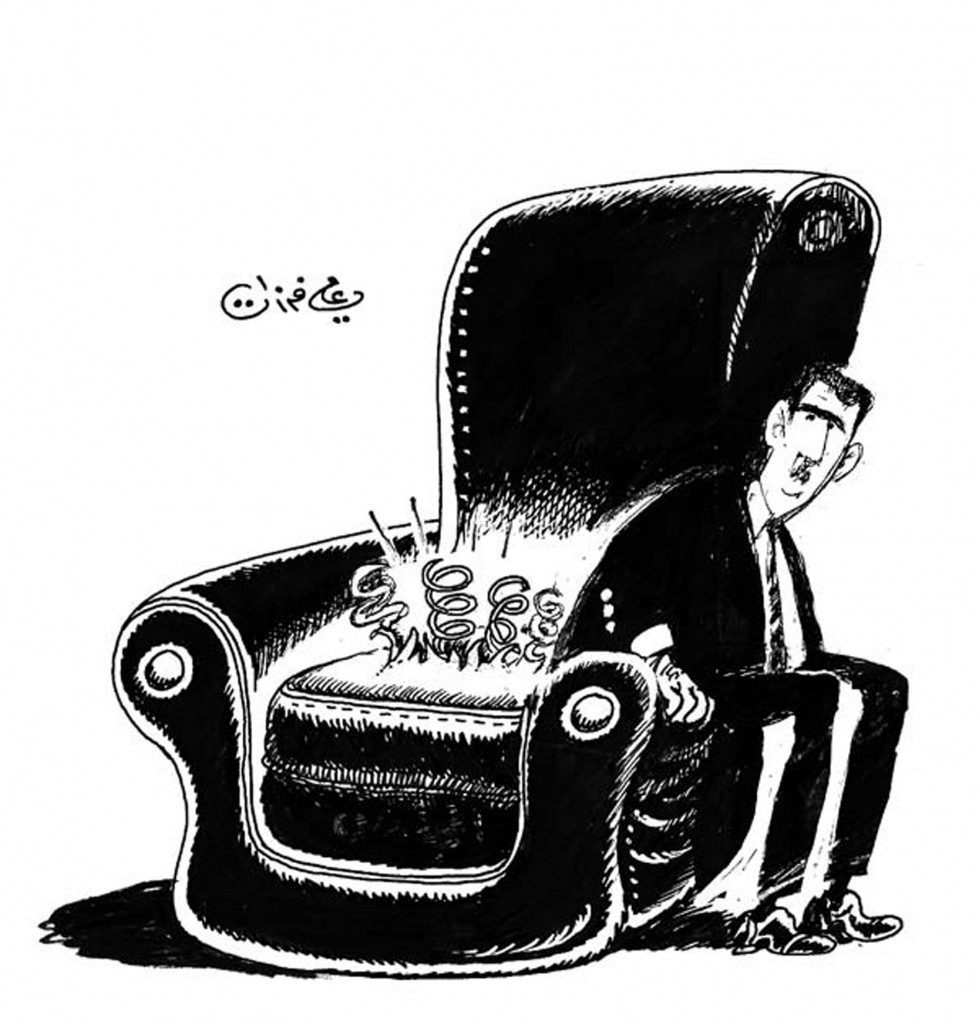 Drawing the president, Ferzat admits, was a personal and political breakthrough — if not foolhardy. “It is quite suicidal to draw someone who is considered a godlike figure for the regime and the Ba’ath party, but still I did it and people respected that courage and started carrying banners with caricatures in the protest to show how they feel about things.”
Drawing the president, Ferzat admits, was a personal and political breakthrough — if not foolhardy. “It is quite suicidal to draw someone who is considered a godlike figure for the regime and the Ba’ath party, but still I did it and people respected that courage and started carrying banners with caricatures in the protest to show how they feel about things.”
Ferzat must have anticipated that his actions might lead to violent repercussions. Last August, pro-regime forces viciously assaulted him and broke both his hands. During the attack, one of the assailants yelled at him, “Bashar’s shoe is better than you.” Article 376 of the Syrian penal code makes it an offence to insult or defame the president, and carries a six-month to three-year prison sentence.
The most lauded cartoonist of the Arab spring, Ferzat has won countless international prizes — including this year’s Index Freedom of Expression Award for the Arts. For more than 40 years, he has been delivering his own scathing messages to dictatorship. Published daily in al Thawra (the Revolution) newspaper in Damascus for a decade, he was a thorn in the side of Hafez al Assad. In the early noughties, the launch of his satirical newspaper al Doumari (the Lamplighter) was considered a hopeful sign in the nascent presidency of Hafez’s heir. Last December, when Bashar al Assad was asked about the attack on Ali Ferzat by the American news commentator Barbara Walters, he responded, “Many people criticise me. Did they kill all of them? Who killed who?’” Such comments made little sense and attest to Ferzat’s power, whether convalescing in a hospital bed or through his drawings.
There are two cartoons by Ferzat embedded in my own visual consciousness of Syria during years of visiting and writing about the country. The first is a drawing of a man whose head has been sliced and popped open at the airport. Instead of searching the luggage on the rack, a uniformed authority figure inspects the contents of the man’s brain. The other is of a dismembered prisoner hanging in a cell, body parts everywhere, while the jailer sits on the floor, sharp implements to hand, crying over a television soap opera. Both of them were a comment on the secret life that routinely takes place in Syria, the self-censorship that is sometimes needed to survive and the ongoing activities inside prisons that are rarely officially acknowledged in the state media.
In a recent exhibition of Ali Ferzat’s work at the MICA gallery in London, there were numerous examples of his coded messages: the armchair of salat (representing ruling power), the shortened ladder to suggest the gulf between the political elite and the nobodies (sometimes in a hole) or the ever busy authority figure waving a roll of toilet paper like a flag. The messages are inescapably clear but their target is not always what one might expect. In one colourful drawing, a man is trying to pluck fruit from a tree, but the three ladders on which he is standing have been laid horizontally, not vertically. Pausing beneath this picture, Ferzat points out: “Yes, I always speak truth to power. Sometimes it’s not only the president to be blamed but the people too.” The gallery, usually closed at the weekend, was filled with Syrians and their families within minutes of its unscheduled opening. Everyone, from grown men to children of all ages, photographed the cartoons on the walls with their mobile phones.
Ferzat’s unique visual vocabulary, developed in extreme circumstances, has had an unexpected reach:
To survive and get around censorship, my caricatures had to be speechless and rely instead on symbols. That gave them an international aspect I did not intend in the first place. So I managed to get the voice of people inside Syria to the outside, through channels of common human interest.
During his stay in London in the spring, Ferzat received good news. There is an interest in reviving al Doumari, with plans to publish it in exile in Dubai and, ultimately, hopefully back home as well. One gets the impression that no matter where Ferzat is — he currently resides in Kuwait because his family thinks it is too dangerous for him to be in Damascus — living away from the revolution has been frustrating. He spends most nights watching the Arabic news channels and drawing until the early hours. His right hand, which was fractured in the attack last summer, remains a little stiff, although that is not evident in the first two cartoons he drew when he was able to move his fingers. One shows an armoured Trojan warhorse with marauding tanks for hooves. The second is, again, a tank poised on its back wheels, ready to crush a lone green shoot sprouting from the ground.
The Syrian people are a major influence on his work. “Drawing is first of all a means and not a purpose in itself,” he says.
The artist is always the one who produces an idea, but if that person is not living within his community then how can he reflect what his community is going through? Art is about being with your own people and having a vision of what they need. You can’t sit in your room isolated behind your window and draw about life — it doesn’t work like that.
The revolution was sparked in March 2011 when young graffiti artists in Deraa, between the ages of nine and 15, were arrested and tortured for writing government slogans on the walls. The sale of spray paint is now banned in Syria unless ID papers are shown.
There have been many false springs in the country’s turbulent political history. A decade ago, and just a few months after Bashar al Assad assumed the presidency, Syrian artists and intellectuals were hopeful that change was possible in their country, a sentiment that began in Ferzat’s case when Bashar al Assad, a “tall dude with a large entourage”, walked into his exhibition filled with censored cartoons. (Ferzat always shows banned cartoons in his exhibitions.) When the new president asked Ferzat how he might be able to gauge popular opinion, the cartoonist urged him to simply talk to the people. Eventually Bashar telephoned him and said he was having a Pepsi with ordinary folk in the street. This was during the so-called Damascus spring of the early noughties, when the regime was courting artists and intellectuals. Imbued by optimism in 2001, Ferzat started his satirical newspaper al Doumari, but as the mood of the political elite reverted to tried and trusted methods, so did the fortunes of his weekly. By the time it closed in 2003, 105 issues later, he had survived two assassination attempts that were never investigated. Thirty-two court cases had been filed against the newspaper and advertisers had stopped advertising.
Historically, cartoonists have been astute in their circumvention of censorship. As Fatma Müge Göçek has shown, under the Ottoman press laws of the early 1900s, they sent erasable drawings to the censors and, after approval, substituted other images in their place. Newspapers at that time also appeared with black boxes where a cartoon had been censored. As the gap widened between official pronouncements and reality – or as Václav Havel once said, ‘People know they are living a lie’ – caricatures became an important means of expression in the Middle East. Now cyberspace provides a comparatively safe haven for pictures and ideas that cannot be expressed in print.
Editorial cartooning, like journalism, is considered a western invention, but the convention of satire in the Middle East is as old as the stories of Alf Laila wa Laila (A Thousand and One Nights). Ferzat’s peers include the Egyptian Baghat Othman, who parodied Sadat, Palestinian Naji al Ali, creator of the Palestinian barefoot boy Hanzala (with his back always to the reader in rejection of the world around him) and Algerian Chawki Amari, now in exile in Paris after serving a three-year sentence in his country for drawing the country’s flags in a cartoon that was seen as ‘defacing’ a national symbol. The Syrians also bring something new to the mix, which springs from a sense of humour coloured by the experience of dictatorship, coupled with sexual innuendo. This blend is nicely demonstrated by a joke from the 1980s that is still pertinent, as recently told to me by a political activist.
A guy used to talk about the president. The mukhabarat, secret police, picked him up and started beating and torturing him. They told him, ‘Stop making jokes about the president. Stop talking about the president. You can tackle whatever issues you want, but in the end you always have to say: this has nothing to do with the president. The president is not aware of this.’ So the minute the guy is released, he sees his family waiting by the door and says, ‘Have you heard, the wife of the president is pregnant and the president has nothing to do with it. He’s not even aware of it.’
Even in his comic strips for juveniles, Ferzat has challenged traditional sensibilities in Syria, a country known for channelling propaganda through state-sponsored children’s publications. Ferzat was 26 years old when he created ‘The Travels of Ibn Battuta” for the popular Usama magazine, published in 1977. In the strip, the famous medieval Arab traveller Ibn Battuta is depicted with a moustache and beard, wearing a turban in the shape of the globe. Ferzat demystifies Ibn Battuta by drawing Muhammad Ali, Omar Sharif and the pop singer Abdel Halim Hafiz, with a turban globe on their heads; as avatars of Ibn Battuta, they respectively box, hug a leading lady and sing. Later in the strip, as the historic traveller pulls his donkey into the present day, his size shrinks, suggesting he is overwhelmed by modern life.
A letter sent to the editor of Usama complained about this portrayal of Ibn Battuta. Ferzat did not use one of the traditional Arab figures of ridicule such as the poet Abu Nuwas or the folk character Juha as his fumbling protagonist, but instead a notable historical personage, which the letter writer found highly insulting. This was at a time when the magazine was already starting to change, and was publishing less controversial material, as Allen Douglas and Fedwa Malti-Douglas show in their study of Arabic comic strips.
Originally from a Sunni Muslim family in Homs, Ferzat describes freedom of the press as “a responsibility”. He stresses:
It’s not as if I should do whatever I feel like doing, regardless of the consequences. It is a matter of moral commitment at the end of the day and varies between countries, depending on the culture and civil liberties. You have to find the right balance. Some newspapers have no obligation, not even morally, and they refrain from nothing and then call it ‘freedom’. Meanwhile other newspapers censor human interest stories. I see both as bad — whether too much suppression in the name of commitment, or too much unethical commitment in the name of freedom. They are both the same.
During prolonged periods of dictatorship, there have been unexpected chinks in the wall of silence, which Lisa Weeden outlines in her tour de force Ambiguities of Domination. One way ordinary Syrians thwarted the cult of Hafez al Assad that pervaded their daily lives was in their choice of newspapers. Throughout the 1970s, al Thawra published a daily editorial cartoon by Ferzat. When he was dropped from the newspaper, al Thawra experienced a 35 per cent drop in sales and was forced to ask the cartoonist to return. Ferzat’s stories about his days there are particularly amusing and they reveal just how much leeway can exist in what at first glance appears to be a monolithic system. In some instances, the offending cartoon would be published in the paper. Then the abusive phone calls from the minister of information would begin.
Ferzat continues:
They came with this new procedure. First the editor-in-chief had to look at the caricature. If he approved it, he had to send it to the general manager. If he approved it, or if he found it controversial and difficult to understand, he had to send it to the minister of information. Take into consideration that the minister of information was a bit of an ass, he would say ‘Yes’ because he didn’t understand it and the next day the people would get the meaning because it only took commonsense. Suddenly the angry phone calls would start all over again.
According to Italian visual critic Donatella Della Ratta, Bashar al Assad’s Syria is ruled by what she calls “a whispering campaign” waged by competing elites, the secret police, the official media and finally the president and his inner circle. All of the different factions are involved in censorship: it takes many pillars of society to control the flow of information and ideas in a totalitarian state.
In such a society, what is the difference between self-censorship and survival for someone like Ferzat? “What I can tell you is that I have no boundaries,” he says.
I don’t have a censor or a policeman in my head before I draw. However, it is not requested of fedayeen — freedom fighters — to be suicidal. As an artist, I’m not going to go and find a landmine and sit on top of it. I invented the symbols that actually manipulate the censor and survive the dangers of punishment. I put simple codes and symbols in my drawings, and anyone who has the capacity to notice things would understand them. That is what I do to secure myself and not be suicidal.
He concludes: “At the end of the day, my drawings and caricatures are part of the daily culture of the street. I want to represent the consciousness of the street, of the people, and I do, and that gives my work value.”
As Ferzat and the graffiti artists of Deraa, who sparked a revolution over a year ago, have shown: Sharpie pens and spray paint can be the most effective tools against a brutal regime.
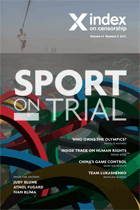
Malu Halasa is a writer and editor. Her books include The Secret Life of Syrian Lingerie (Chronicle Books)
This article appears in the new edition of Index on Censorship. Click on The Sports Issue for subscription options and more
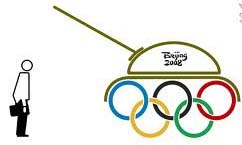 Despite talk of reform, the Bahrain Grand Prix and the Beijing Olympics proved to be catalysts for rights abuses. Mihir Bose asks whether human rights should be a criterion for hosting coveted international sporting events
Despite talk of reform, the Bahrain Grand Prix and the Beijing Olympics proved to be catalysts for rights abuses. Mihir Bose asks whether human rights should be a criterion for hosting coveted international sporting eventsOn the evening of 13 July 2001, as Beijing held a press conference in Moscow to celebrate securing the 2008 Olympics, they had an unexpected visitor: François Carrard, the Swiss lawyer who was executive director of the International Olympic Committee (IOC). Normally on such occasions the IOC keeps its distance and lets the victorious city have its moment in the sun. But Carrard felt he had to address the media on the human rights issue.
In the lead-up to the vote, Beijing’s rivals, in particular Toronto and Paris, had made much of China’s human rights record. As the members gathered, some 50 protesters assembled outside chanting “Free Tibet”. The Russian police, some wearing riot gear, broke up the protest and six people were seen being taken away in a waiting bus after demonstrators tried to unfurl three banners on the Moscow River embankment, opposite the World Trade Centre where the IOC was meeting. There were reports of 12 arrests.
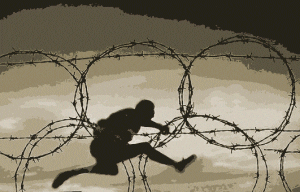 The IOC had so far refused to discuss human rights, arguing that it was only concerned with making a decision about sport. Nor was the issue addressed by the Evaluation Commission that visited the bid cities and whose assessment formed the basis of the IOC members’ decision. The report of the commission was crucial as, following the revelation of the 1998 Salt Lake City corruption scandal in which IOC members were accused of taking bribes, they were subsequently barred from visiting bid cities. Just before the vote for the 2008 Games, Hein Verbruggen, the Dutch chairman of the Evaluation Commission, summarised to his fellow members the various potential risk factors of the bidding cities. But he did not mention human rights.
The IOC had so far refused to discuss human rights, arguing that it was only concerned with making a decision about sport. Nor was the issue addressed by the Evaluation Commission that visited the bid cities and whose assessment formed the basis of the IOC members’ decision. The report of the commission was crucial as, following the revelation of the 1998 Salt Lake City corruption scandal in which IOC members were accused of taking bribes, they were subsequently barred from visiting bid cities. Just before the vote for the 2008 Games, Hein Verbruggen, the Dutch chairman of the Evaluation Commission, summarised to his fellow members the various potential risk factors of the bidding cities. But he did not mention human rights.
Beijing did face a question on human rights during its presentation. But this was delivered in such a roundabout way that only seasoned IOC observers could have understood it. Roland Baar, a rower from Germany, raised the ethical issue of playing beach volleyball in Tiananmen Square. Beijing had proposed this idea, but it had been shelved after objections from the Evaluation Commission that it was not a suitable venue. Baar was so circumspect that he did not even utter the words “Tiananmen Square”, lest it offend the Chinese.
But now Carrard felt free to talk about human rights. At the press conference, apologising profusely for intervening at the Chinese party, he revealed, “On human rights we had two choices — a decision we close the door and that is a hugely respectable decision. The other way is to bet on openness. We bet that in seven years’ time the interactions, the progress and the development will be such that human rights can be improved.”
Long before the Beijing Olympics was staged it was clear that this was an impossible bet, and in the end Jacque Rogge, who was elected president of the IOC a few days after the vote in Moscow, made it clear that it was no business of the committee to monitor China’s moral development. Indeed, Rogge confessed that the IOC neither had the power nor the ability to do anything on human rights. The result: China rode out the protests that accompanied the Games, in particular the ones that marked the torch relay. China, as it had always planned, used the Games to show they could take the Olympics, a western invention, and do it better. By the end of it, IOC members were applauding the Games as China’s giant coming-out party and declaring the bar had been raised to such an extent that other countries would struggle to match it. All talk of human rights and opening up the country had vanished.
The fact was that the Games went to Beijing not because the Olympic movement thought it could change China, but because of wider geopolitical considerations. The overwhelming view of IOC members was that the Games had to go to the most populous country in the world. China had been a good Olympic member. Whatever its human rights record, there was no Olympic reason to refuse the bid. There was also a fear that Beijing, having failed in 1993 when it lost to Sydney by two votes, might walk out of the Olympics if China did not succeed this time.
There was a dominant view in the Olympic movement that, with the collapse of the Soviet Union, a strong China was needed to balance the all-powerful Americans. Ivan Slavkov, the IOC member from Bulgaria — later expelled from the movement in 2005 when he was caught by an undercover reporter saying he would take bribes in exchange for votes — said at the time: “We need China to act as a check on the US. The US is the only superpower. It dominates everything, including the Olympics and the medal tables. China is coming up fast and, by giving the Games to them, we can make sure they develop in the right direction.”
The IOC’s dance round the issue of human rights over the decades illustrates a wider problem for all sports organisations faced with such ethical concerns. The classic example of this was the 1936 Berlin Olympics. The award of the Games to Berlin was intended to symbolise the re-admission of a peaceful, democratic Germany to the family of nations after the horrors of the First World War. By a supreme irony, the Games have gone down in history as a triumph of Nazi propaganda. As the official Olympic-Zeitung proudly asked on 19 August 1936: “Do we have to point out that the great victor at the Olympic Games is Adolf Hitler?”
The 1936 Olympics, which left us the legacy of the torch relay, offers a template for the use of sport for ulterior purposes with its extraordinary mixture of opportunism, improvisation and attention to detail in the Nazi preparations for the Games. But Hitler could not have fulfilled his agenda to show how normal his regime was if leaders of international sport had not played into his hands, with their willingness to believe dishonest public assurances and to accept gestures and symbols rather than look at reality.
Since then, sports leaders have often looked the other way when major sporting events are held against a background of state violence, in countries whose repressive regimes seek to present themselves as open societies to the outside world. The list includes rebel South African cricket tours of the apartheid era, financed by tax concessions by the white regime, the 1968 Mexico Olympics, the Ali-Foreman fight in 1974 in a Zaire ruled by the brutal and corrupt despot Mobutu Sese Seko, and the 1978 World Cup in Argentina, organised by a junta which, even then, was embarking on a massive programme of killing people opposed to the regime.
Back in 1851, when Prince Albert wished to advertise the might of Queen Victoria’s realm he held a Great Exhibition — essentially a trade fair displaying the works of industry of all nations. There was culture in the form of Charlotte Bronte, Lewis Carroll and George Eliot, but no sport.
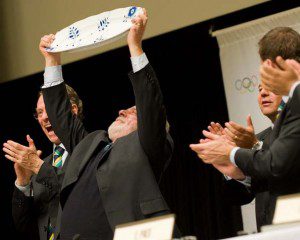 Today, sporting events have come to replace trade expos as a symbol of national success. Nelson Mandela used the power of sport, particularly rugby, to woo the whites, and felt that the rainbow nation had arrived when in 2010 it became the first African country to stage the football World Cup. In Copenhagen in 2009, President Lula of Brazil shed tears after Rio won the right to stage the 2016 Olympics. “Everybody talks of Brazil as the country of tomorrow,” he said. “Here in Copenhagen tomorrow has arrived.” His pleasure was all the greater as Rio had beaten Barack Obama’s Chicago, despite the fact that the most powerful man in the world made a personal plea to the IOC.
Today, sporting events have come to replace trade expos as a symbol of national success. Nelson Mandela used the power of sport, particularly rugby, to woo the whites, and felt that the rainbow nation had arrived when in 2010 it became the first African country to stage the football World Cup. In Copenhagen in 2009, President Lula of Brazil shed tears after Rio won the right to stage the 2016 Olympics. “Everybody talks of Brazil as the country of tomorrow,” he said. “Here in Copenhagen tomorrow has arrived.” His pleasure was all the greater as Rio had beaten Barack Obama’s Chicago, despite the fact that the most powerful man in the world made a personal plea to the IOC.
But the problem for sport is that, unlike expos, it carries a moral dimension. It is interesting to note that Beijing’s rivals made much of this distinction. Claude Bébéar, president of the Paris bid, made it clear he would have no problems with a Chinese city hosting an expo, but not the Olympics. Giving China the Games, he argued, would indicate moral approval for the regime.
The idea that sport had universal significance emerged only in the 19th century as the rules for modern sports were being formulated. In his fictional novel Tom Brown’s Schooldays, Thomas Hughes presented his headmaster at Rugby, Thomas Arnold, as a sporting guru. His message, said Hughes, was that sport could reach out beyond the playing fields more effectively than any other form of human activity. Indeed, sport could shape society for the greater good.
The headmaster of Hughes’s book was an invention — the real life Arnold had no interest in sport. But the idea proved so powerful that it seduced a French baron, Pierre de Coubertin, who came to Rugby to worship at Arnold’s shrine and used his principles to revive the Olympics, setting it a high political goal. As he put it:
It is clear the telegraph, railways, the telephone, the passionate research in science, congresses and exhibitions have done more for peace than any treaty or diplomatic convention. Well, I hope that athletics will do even more … let us export runners and fencers; there is a freetrade of the future, and on the day when it is introduced within the walls of old Europe the cause of peace would have received a new and mighty stay.
Modern sport is essentially the marriage of Hughes’s big idea in the private realm – that sport develops character — with Coubertin’s big idea in the public realm — that sport can transmit values within and between nations through regular international competition.
The problem arises when sport collides with political reality, as it did in the wake of the Arab spring. As millions rose up in the Arab world last year to challenge and even change their despotic rulers, in Bahrain the desire for freedom came into conflict with modern sport. In the picturesque words of the Daily Mail’s Martin Samuel, the result of “little brown people” wanting freedom meant “the next thing you know is there is one less place for rich white guys to race cars”.
Formula One’s first Grand Prix of the season was due to take place in Bahrain in March, just weeks after the kingdom had been engulfed by protesters demanding more freedom. There had been highly publicised protests at the main Pearl Roundabout in the financial district of Manama with some 31 protesters killed. Armoured cars, including Saudi troops and forces from Qatar and UAE, had rolled into the kingdom to restore order. How could a sports event take place in such a climate? And where was the moral compass of sport in even thinking it could?
The race was the dream of Crown Prince Sheikh Salman bin Hamad bin Isa al Khalifa, who had made it clear that money was no object in bringing one of the most high profile world events to his desert kingdom. The Bahrain government funded the race. The Sakhir circuit, where the Grand Prix had been run since 2004, had cost some £92m. The F1 organisers had been paid £24.6m to allow Bahrain to organise the opening race of the 2010 season, and this had risen by 60 per cent for the 2011 race. The protesters knew how dear the race was to the Crown Prince and that if they wanted to wring political concessions from him, they had to hit at his beloved sport.
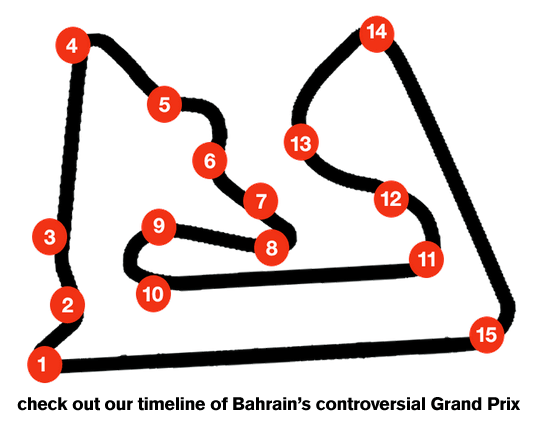 However, the F1 organisers of the race did not seem to understand the moral questions involved. Neither FIA, the governing body, nor Bernie Ecclestone — the F1 rights holder — wanted to put their heads above the parapet. Their reluctance, it was assumed, was due to the fear that if they cancelled the race they would stand to lose £37m in rights fees.
However, the F1 organisers of the race did not seem to understand the moral questions involved. Neither FIA, the governing body, nor Bernie Ecclestone — the F1 rights holder — wanted to put their heads above the parapet. Their reluctance, it was assumed, was due to the fear that if they cancelled the race they would stand to lose £37m in rights fees.
In the end, the Crown Prince himself decided the race had to be put back, hoping it could be held later in the year. His wish appeared to have been granted when, following an FIA inspection team visit, FIA’s World Council unanimously agreed that the Bahrain Grand Prix would now be held on 30 October. The decision provoked outrage from human rights activists and race fans. Many argued that for all the talk of high values, sport was more bothered about Mammon and ended up conspiring with despots.
The FIA’s judgement was further called into question when details of the inspection report emerged. Over a two-day trip, the FIA had met the minister of culture and tourism, the minister of the interior, had had lunch with the board that runs the Grand Prix, met circuit personnel and visited a shopping centre. But they had not met any of the dissidents. It was clear that the race could now not go ahead at the rescheduled date either. However, it was logistics not morality that was given as the reason for the cancellation. The new date for the race in October meant Bahrain would get India’s Grand Prix schedule – the new Formula One commercial centre – and extend the calendar into December. The teams just could not cope with the pressures this would create.
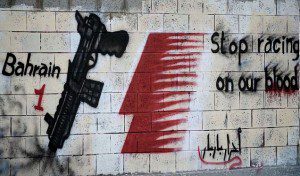 The whole affair brought little credit to Formula One, least of all the highly paid drivers. Apart from Red Bull’s Mark Webber, who acknowledged the moral question of sport taking place in the wake of a bloodbath, nearly all the other drivers avoided the moral issue. I could not even coax Britain’s most successful F1 driver, Nigel Mansell — who has chalked up 31 race wins and the 1992 world title — to take a stand on this issue. When I asked in the middle of the crisis whether it would be morally justified to stage the Bahrain Grand Prix, Mansell replied: “There are great people involved in Formula One who are in charge and it is up to them to speak to the power brokers of the country.”
The whole affair brought little credit to Formula One, least of all the highly paid drivers. Apart from Red Bull’s Mark Webber, who acknowledged the moral question of sport taking place in the wake of a bloodbath, nearly all the other drivers avoided the moral issue. I could not even coax Britain’s most successful F1 driver, Nigel Mansell — who has chalked up 31 race wins and the 1992 world title — to take a stand on this issue. When I asked in the middle of the crisis whether it would be morally justified to stage the Bahrain Grand Prix, Mansell replied: “There are great people involved in Formula One who are in charge and it is up to them to speak to the power brokers of the country.”
The problem here, as Max Mosley, the former head of FIA, astutely put it was:
The Formula One world did not seem to appreciate that the government in Bahrain was about to use the Grand Prix in support of suppressing human rights.
For all the moral high ground Formula One may like to claim, when faced with a stark ethical issue it is powerless and has to duck and dive. The same drama has played itself out again this year, with F1 facing international condemnation for holding the race in Bahrain.
Sports administrators may present themselves as the Vatican of sport, beyond the control of any authority but their own. Yet the money needed to run modern sport means they have to compromise with dubious governments and regimes. The result is that the high moral purpose of sport is sacrificed if not totally ignored. And until sport can deal with this basic contradiction, problems such as Bahrain will continue to appear. The worrying thing is that few in sport seem willing or able to deal with it.
 Mihir Bose is the author of The Spirit of the Game: How Sport Made the Modern World (Constable)
Mihir Bose is the author of The Spirit of the Game: How Sport Made the Modern World (Constable)
This article appears in the summer 2012 edition of Index on Censorship magazine. Click on
The Sports Issue for subscription options and more
On 12 June, the Tunisian Ministry of Culture decided to temporarily close Palais El-Abdelia, where the controversial Pritemps des Arts fair’s closing ceremony took place last Sunday. On the night of 10 June, ultra-conservative Islamists attacked the gallery, claiming that it exhibited artworks offensive to Islam.
During a press conference, the Tunisian culture minister, Mehdi Mabrouk, said that some of the artworks exhibited at Printemps des Arts did transgress Islamic holy symbols — something the fair’s artists deny. He also said that some of these artworks are now under investigation.
“In art, there is provocation. Art sometimes provokes, and this is its role. But there is a red line which separates provocation and the assault on sacred symbols”, said the minister.
After acknowledging the provocative role of art, Mabrouk told Radio Shems FM on the morning of 14 June that six works deemed to be “provocative” had been confiscated.
“There were not art works assaulting sacred symbols, unless Salafis are considered sacred,” said Amor Ghedasmi, the secretary general for Syndicate for Plastic Artists, also speaking on Radio Shems FM. The fair did contain several works criticising Salafis, who advocate for a hardline interpretation of Islam.
He denied that the exhibition featured a work of art depicting the prophet Mohammed. Pictorial representations of prophets and god are considered forbidden in Sunni Islam.
Ghedasmi also offered his own interpretation of a controversial work of art, in which the phrase “Glorious is Allah” is spelled out in ants. “The work illustrates a boy bearing a back bag. It symbolises the heavy burden of education and discipline. Ants are also known to be hard-working, and disciplined too”, he said.
“I ask the ministries of culture and religious affairs to show us the artworks [which they described as offensive to Islam] and also give us their interpretations,” he added.
The Tunisian Ministry of Culture is planning to lodge a complaint against the fair’s organisers for “assaulting the feelings of the fair’s visitors”. Palais El-Abdelia will stay closed until a committee to oversee it is formed.
The Tunis Printemps des Arts (Spring of Arts), a modern contemporary art fair, ended on 10 June after 10 days of exhibitions and competition. The closing ceremony, which was supposed to be a celebration of art, was characterised by controversy, censorship and violence.
One of the artworks in question illustrates a naked woman, whose intimate parts are covered by a Couscous plate (a popular Tunisian dish). The woman is surrounded by dark, bearded men. The second work illustrates a bearded superman carrying another bearded man in his arms.
“They said that they would come back at 6 pm, and that they would rather not find the paintings,” said Aicha Gorgi, a gallery owner and artist. “They did come back at 6pm, their number grew, and they gathered in front of Palais El-Abdelia,” she added.
Police interfered to prevent any clashes between the artists and the ultra-conservative group. But later on in the night and after the closure of the art gallery, the ultra-conservatives came back in larger numbers and succeeded in invading El-Abdelia art gallery. They burned and destroyed a number of artworks.
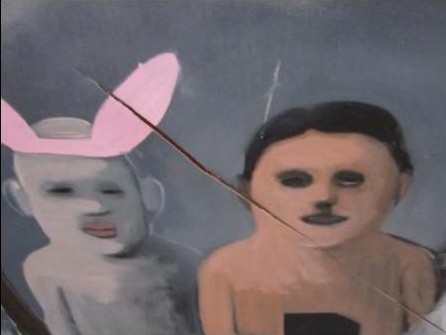
“Police did not allow them to enter, but they climbed over the rear walls and entered the gallery,” Gorgi said in a testimony given to Radio Mosaïque FM. “They burned the work of Faten Gaddass, and tore to pieces two linen artworks, one by Mohamed Ben Slama, and the second by a French artist. At my stand, I also found Aicha Filali’s work destroyed.”
This is not the only censorship story which characterised this year’s Printemps Des Arts edition. Last week, young Tunisian artist Elektro Jaye claimed that the state put pressure on the fair’s organisers to take down his work.